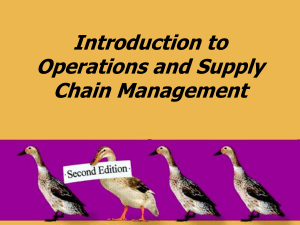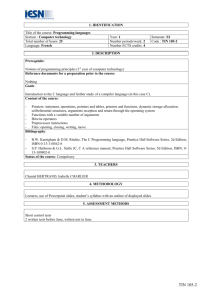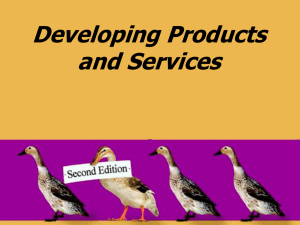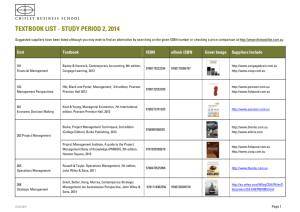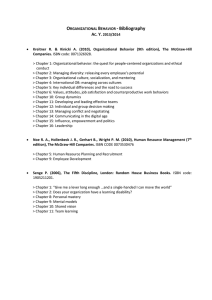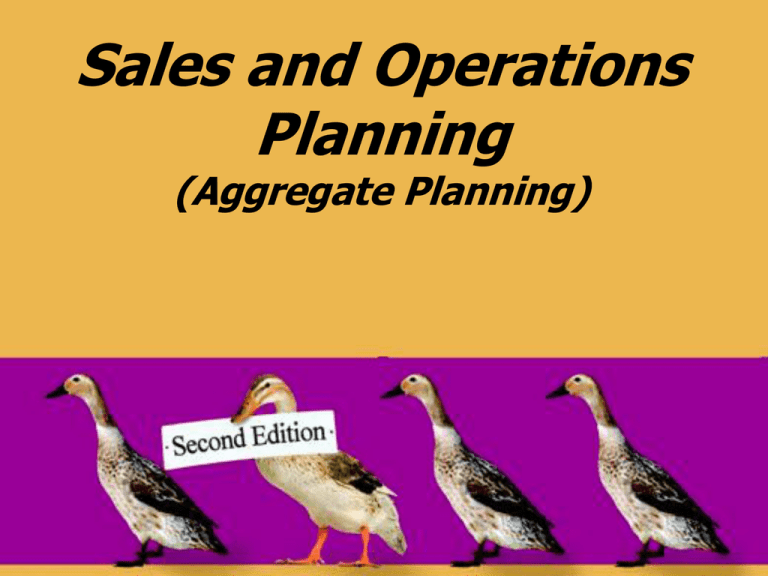
Sales and Operations
Planning
(Aggregate Planning)
Chapter Objectives
Be able to:
Distinguish among strategic planning, tactical planning, and
detailed planning and control.
Describe why sales and operations planning (S&OP) is
important to an organization and its supply chain partners.
Generate multiple alternative sales and operations plans.
Describe the differences between top-down and bottom-up
S&OP and discuss the strengths and weaknesses of level,
chase, and mixed production strategies.
Discuss the organizational issues that arise when firms decide
to incorporate S&OP into their efforts.
Examine how S&OP can be used to coordinate activities up and
down the supply chain.
Apply optimization modeling techniques to the S&OP process.
© 2008 Pearson Prentice Hall --- Introduction to Operations and Supply
Chain Management, 2/e --- Bozarth and Handfield, ISBN: 0131791036
Chapter 13, Slide 2
Sales and Operations Planning
Involves:
• Strategic and tactical considerations
• Top-down planning
• Bottom-up planning
• Optimization techniques
© 2008 Pearson Prentice Hall --- Introduction to Operations and Supply
Chain Management, 2/e --- Bozarth and Handfield, ISBN: 0131791036
Chapter 13, Slide 3
Sales and Operations Planning
(S&OP)
• Purpose: Select capacity options over
the intermediate time horizon
• Capacity options:
– Workforces
– Shifts
– Overtime
– Subcontracting
– Inventories
– etc.
© 2008 Pearson Prentice Hall --- Introduction to Operations and Supply
Chain Management, 2/e --- Bozarth and Handfield, ISBN: 0131791036
Chapter 13, Slide 4
Time Horizon View . . .
Short-Range Plan
(days, weeks out)
S&OP
(months out)
Long-Range Plan
(years out)
Capacity levels
considered
“frozen” in the
short-term
Changes in
adjustable
capacity
possible
Changes in
fixed
capacity
possible
© 2008 Pearson Prentice Hall --- Introduction to Operations and Supply
Chain Management, 2/e --- Bozarth and Handfield, ISBN: 0131791036
Chapter 13, Slide 5
S&OP continued
(2 - 18 months out)
• Outside of time frame strategic planning
• Inside of time frame tactical planning
“Big Picture” approach to planning
• Families or groups (aggregation) of:
– Products
– Resources
– Technologies or skills
• Provide “rough” estimates
© 2008 Pearson Prentice Hall --- Introduction to Operations and Supply
Chain Management, 2/e --- Bozarth and Handfield, ISBN: 0131791036
Chapter 13, Slide 6
Position in the Overall
Business Planning Cycle
Decisions
Long-Range
Plans
S&OP
Short-Range
Plans
Product and process
“Bricks and Mortar”
Employment and overall
inventory levels
What demand to meet?
Specific products and times
Scheduling of people and
equipment
© 2008 Pearson Prentice Hall --- Introduction to Operations and Supply
Chain Management, 2/e --- Bozarth and Handfield, ISBN: 0131791036
Time Frame
18+ months
2 to 18 months
Less than 2 months
Chapter 13, Slide 7
Inputs to the Process
Strategic Capacity Levels
Existing buildings
Processes
Demand Management
Forecasts of customer
demand
Need for spares, etc.
Pricing
S&OPs
External Capacities
Suppliers
Subcontractors
© 2008 Pearson Prentice Hall --- Introduction to Operations and Supply
Chain Management, 2/e --- Bozarth and Handfield, ISBN: 0131791036
Chapter 13, Slide 8
Advantages of S&OP
• Negotiated process
– “Agreed” demand
• Functional coordination
– Budgets and cash flow analyses
• Reduces operations and supply chain
tasks to “meeting the plan”
© 2008 Pearson Prentice Hall --- Introduction to Operations and Supply
Chain Management, 2/e --- Bozarth and Handfield, ISBN: 0131791036
Chapter 13, Slide 9
S&OP Approaches
Top-Down
Bottom-Up
• Similar products OR
stable mix
• Different products AND
unstable mix
• Standards available for
planning
• Requires forecasts and
production data for
individual products
– time, cost requirements
from history and/or
planning documentation
• Can “Average” product
• Can be extremely dataintensive
© 2008 Pearson Prentice Hall --- Introduction to Operations and Supply
Chain Management, 2/e --- Bozarth and Handfield, ISBN: 0131791036
Chapter 13, Slide 10
Planning Values
Translate forecast into:
– Resources required
•
•
•
•
Labor hours per unit
Material quantities
Equipment hours
Subcontractors?
– Costs
•
•
•
•
•
Materials
Labor
Subcontractors?
Hiring/firing costs
Inventory holding costs
© 2008 Pearson Prentice Hall --- Introduction to Operations and Supply
Chain Management, 2/e --- Bozarth and Handfield, ISBN: 0131791036
Chapter 13, Slide 11
Top-Down Planning
1. Develop the aggregate sales forecast
and planning values.
2. Translate the sales forecast into resource
requirements.
Personnel, equipment, materials
3. Generate alternative production plans.
Chase, level, mixed
Select the best of the plans.
Lowest cost, best fit to capability
© 2008 Pearson Prentice Hall --- Introduction to Operations and Supply
Chain Management, 2/e --- Bozarth and Handfield, ISBN: 0131791036
Chapter 13, Slide 12
Top-Down Example I
(Pennington Cabinet Product Data)
Product
% of Total
Labor/Unit
A100
10%
40 hours
B200
50%
20 hours
C300
20%
15 hours
D400
5%
10 hours
E500
10%
20 hours
F600
5%
10 hours
© 2008 Pearson Prentice Hall --- Introduction to Operations and Supply
Chain Management, 2/e --- Bozarth and Handfield, ISBN: 0131791036
Chapter 13, Slide 13
Top-Down Example II
(“Average” Products)
Product
% of Total Labor/Unit
A100
10%
40 hours
B200
50%
20 hours
C300
20%
15 hours
D400
5%
10 hours
E500
10%
20 hours
F600
5%
10 hours
10%(40) + 60%(20) + 20%(15) + 10%(10) = 20 hours
© 2008 Pearson Prentice Hall --- Introduction to Operations and Supply
Chain Management, 2/e --- Bozarth and Handfield, ISBN: 0131791036
Chapter 13, Slide 14
Top-Down Example III
(Conditions or Constraints)
• Agreed upon demand to be met for
upcoming 12 month period
• Can vary workforce and inventory levels
• No backordering
• “Average” unit requires 20 worker hours
• Each worker works 160 hours per month
© 2008 Pearson Prentice Hall --- Introduction to Operations and Supply
Chain Management, 2/e --- Bozarth and Handfield, ISBN: 0131791036
Chapter 13, Slide 15
Top-Down Example IV
(Demand Forecast for 12 months)
Month
Demand
Month
Demand
January
750
July
910
February
760
August
910
March
800
September
910
April
800
October
880
May
820
November
860
June
840
December
840
© 2008 Pearson Prentice Hall --- Introduction to Operations and Supply
Chain Management, 2/e --- Bozarth and Handfield, ISBN: 0131791036
Chapter 13, Slide 16
Top-Down Example V
(Other tidbits of data …)
• Start and end with 100 workers (goal)
• Start and end with about 100 units in
inventory (goal)
The above conditions allow fair cost
comparisons of various aggregate plans.
© 2008 Pearson Prentice Hall --- Introduction to Operations and Supply
Chain Management, 2/e --- Bozarth and Handfield, ISBN: 0131791036
Chapter 13, Slide 17
Pennington Cabinet
• Strategic Capacity Level: 848 jobs per month
• Company produces make-to-stock cabinets for sale at
Lowe’s, etc.
• Planning values:
–
–
–
–
–
–
–
–
Average hours of labor per cabinet = 20 hours
Regular production cost = $2000 per cabinet set
Overtime production cost = $2062 per cabinet set
Average monthly holding cost = $40 per cabinet set
Hours per month per employee = 160 hours
Hiring cost = $1750 per employee
Layoff cost = $1500 per employee
Allowable overtime = 16 hours per employee
© 2008 Pearson Prentice Hall --- Introduction to Operations and Supply
Chain Management, 2/e --- Bozarth and Handfield, ISBN: 0131791036
Chapter 13, Slide 18
Pennington (continued)
Raw Demand for next 7 months:
January
750 jobs
February
760
March
800
April
800
May
820
June
840
July
910
What are our options . . . ?
© 2008 Pearson Prentice Hall --- Introduction to Operations and Supply
Chain Management, 2/e --- Bozarth and Handfield, ISBN: 0131791036
Chapter 13, Slide 19
Pennington (again) . . .
Raw Demand
1000
Monthly capacity = 848
500
Need 910
July
© 2008 Pearson Prentice Hall --- Introduction to Operations and Supply
Chain Management, 2/e --- Bozarth and Handfield, ISBN: 0131791036
Chapter 13, Slide 20
Detail of First Seven Months
from Level Strategy
Employees
to Meet
Production
Plan
Actual
Employees
Actual
Production
Month
Demand
Demand in
Employee
Hours
January
750
15000
94
105
February
760
15200
95
March
800
16000
April
800
May
Ending
Inventory
Hirings
Layoffs
840
5
0
190
105
840
0
0
270
100
105
840
0
0
310
16000
100
105
840
0
0
350
820
16400
103
105
840
0
0
370
June
840
16800
105
105
840
0
0
370
July
910
18200
114
105
840
0
0
300
Note: We develop a level strategy by setting “Actual Employees” equal to the
average required for the 12 month planning period
© 2008 Pearson Prentice Hall --- Introduction to Operations and Supply
Chain Management, 2/e --- Bozarth and Handfield, ISBN: 0131791036
Chapter 13, Slide 21
Level Plan Cost Details for
the Full Year from the Text
© 2008 Pearson Prentice Hall --- Introduction to Operations and Supply
Chain Management, 2/e --- Bozarth and Handfield, ISBN: 0131791036
Chapter 13, Slide 22
Detail of First Seven Months
from Chase Strategy
Employees
to Meet
Production
Plan
Actual
Employees
Actual
Production
Month
Demand
Demand in
Employee
Hours
January
750
15000
94
94
February
760
15200
95
March
800
16000
April
800
May
Ending
Inventory
Hirings
Layoffs
752
0
6
102
105
760
1
0
102
100
105
800
5
0
102
16000
100
105
800
0
0
102
820
16400
103
105
824
3
0
106
June
840
16800
105
105
840
2
0
106
July
910
18200
106
105
848
1
0
106
Note: We develop a chase strategy by setting “Actual Employees” equal to
the number needed in each period subject to maximum capacity constraint of
848 (see July, here remaining demand of 62 units is done by using overtime).
© 2008 Pearson Prentice Hall --- Introduction to Operations and Supply
Chain Management, 2/e --- Bozarth and Handfield, ISBN: 0131791036
Chapter 13, Slide 23
Chase Plan Cost Details for
the Full Year from the Text
© 2008 Pearson Prentice Hall --- Introduction to Operations and Supply
Chain Management, 2/e --- Bozarth and Handfield, ISBN: 0131791036
Chapter 13, Slide 24
Mixed Strategy
A compromise between level and chase plan
extremes to reduce total cost.
For the Pennington example, we
• Keep 100 employees at beginning, which builds
up inventory slowly
• Reduces hiring/layoff costs by only changing
workforce gradually
• Use overtime only toward the end of the year.
© 2008 Pearson Prentice Hall --- Introduction to Operations and Supply
Chain Management, 2/e --- Bozarth and Handfield, ISBN: 0131791036
Chapter 13, Slide 25
Mixed Plan Cost Details for
the Full Year from the Text
© 2008 Pearson Prentice Hall --- Introduction to Operations and Supply
Chain Management, 2/e --- Bozarth and Handfield, ISBN: 0131791036
Chapter 13, Slide 26
Top-Down Example
(Other Issues …)
• Are complete costs shown?
– Expand out for budget and cash flow analysis
• “Input” (suppliers) and “output” (logistics and
warehousing) considerations
– Lead time, materials availability, storage space?
• Variations in actual production
– Scrap, rework, equipment breakdowns
© 2008 Pearson Prentice Hall --- Introduction to Operations and Supply
Chain Management, 2/e --- Bozarth and Handfield, ISBN: 0131791036
Chapter 13, Slide 27
Top-Down Option
(We could subcontract production)
• Maximum subcontract of ??? units/month..
• Cost is more per unit than internal production cost
• Will this option:
– 1) increase costs?
– 2) decrease costs?
– 3) have no effect on costs?
• Issues:
– Quality?
– Source of materials (separate supplier allowed?)
– Loss of proprietary information
© 2008 Pearson Prentice Hall --- Introduction to Operations and Supply
Chain Management, 2/e --- Bozarth and Handfield, ISBN: 0131791036
Chapter 13, Slide 28
Bottom-Up Iterative Approach
(Similar to Top Down)
Develop Production
Plans for Distinct
Families or Otems
NO
Determine
Total
Load
Check feasibility:
– Bottleneck processes
– Key suppliers
– Other resources (cash)
Feasible?
YES
© 2008 Pearson Prentice Hall --- Introduction to Operations and Supply
Chain Management, 2/e --- Bozarth and Handfield, ISBN: 0131791036
Implement Plan
Chapter 13, Slide 29
Detail from Philips Toys Bottom
Up Plan
© 2008 Pearson Prentice Hall --- Introduction to Operations and Supply
Chain Management, 2/e --- Bozarth and Handfield, ISBN: 0131791036
Chapter 13, Slide 30
… and Load Profile for
Production
© 2008 Pearson Prentice Hall --- Introduction to Operations and Supply
Chain Management, 2/e --- Bozarth and Handfield, ISBN: 0131791036
Chapter 13, Slide 31
Cash Flow Analysis
Net cash flow = cash inflows – cash outflows
Different sales scenarios can have significant effect on cash flow as shown
for the Pennington example in the text.
© 2008 Pearson Prentice Hall --- Introduction to Operations and Supply
Chain Management, 2/e --- Bozarth and Handfield, ISBN: 0131791036
Chapter 13, Slide 32
Advanced Topic:
Optimization Modeling
• What is optimization modeling?
• Essential conditions
• Application to operations problems
© 2008 Pearson Prentice Hall --- Introduction to Operations and Supply
Chain Management, 2/e --- Bozarth and Handfield, ISBN: 0131791036
Chapter 13, Slide 33
Optimization Modeling
Family of mathematical techniques
used to allocate limited resources
among competing demands in an
optimal way
What is our financial objective?
What are our constraints?
© 2008 Pearson Prentice Hall --- Introduction to Operations and Supply
Chain Management, 2/e --- Bozarth and Handfield, ISBN: 0131791036
Chapter 13, Slide 34
Optimization Example 1
Product mix:
Find the product mix that will
maximize revenue, given limits on
materials, labor hours, and machine
hours available
© 2008 Pearson Prentice Hall --- Introduction to Operations and Supply
Chain Management, 2/e --- Bozarth and Handfield, ISBN: 0131791036
Chapter 13, Slide 35
Optimization Example 2
S&OP:
Find the workforce and inventory
levels which will minimize hiring, layoff,
and inventory costs while still meeting
demand.
© 2008 Pearson Prentice Hall --- Introduction to Operations and Supply
Chain Management, 2/e --- Bozarth and Handfield, ISBN: 0131791036
Chapter 13, Slide 36
Choosing Between Plans
•
•
•
•
•
•
Effect on supply chain partners?
What are the cash flows like?
Is there space for the inventory?
Effects on the workforce morale?
Is staffing available when needed?
How flexible is the plan?
© 2008 Pearson Prentice Hall --- Introduction to Operations and Supply
Chain Management, 2/e --- Bozarth and Handfield, ISBN: 0131791036
Chapter 13, Slide 37
Options for Services
Smooth out demand:
Appointments
Discounts and promotions
Seasonal complements
Yield management
Tiered workforce:
Full-time and part-time
Customer involvement (offloading)
© 2008 Pearson Prentice Hall --- Introduction to Operations and Supply
Chain Management, 2/e --- Bozarth and Handfield, ISBN: 0131791036
Chapter 13, Slide 38
Linking S&OP Throughout the
Supply Chain
Good information
systems (EDI) are
necessary for
success,
flexibility, and
reducing
uncertainty
© 2008 Pearson Prentice Hall --- Introduction to Operations and Supply
Chain Management, 2/e --- Bozarth and Handfield, ISBN: 0131791036
Chapter 13, Slide 39
S&OP Optimization
Two major types of problems
1. Maximize profit or revenues subject
to resource constraints
2. Minimize costs subject to demand
requirements
© 2008 Pearson Prentice Hall --- Introduction to Operations and Supply
Chain Management, 2/e --- Bozarth and Handfield, ISBN: 0131791036
Chapter 13, Slide 40
Optimization
Essential Conditions I
1. Explicit objective function
Maximize revenue or profit
Minimize costs
2. Some constraint(s)
Resource limits
Demand requirements
© 2008 Pearson Prentice Hall --- Introduction to Operations and Supply
Chain Management, 2/e --- Bozarth and Handfield, ISBN: 0131791036
Chapter 13, Slide 41
Optimization
Essential Conditions II
3. Conditions can be expressed
mathematically
Revenue = $1000X
Variable cost = $310X
Assembly hours needed = 15X
4. Divisibility
OK to make half a unit or hire two thirds
of an individual
© 2008 Pearson Prentice Hall --- Introduction to Operations and Supply
Chain Management, 2/e --- Bozarth and Handfield, ISBN: 0131791036
Chapter 13, Slide 42
Optimization Example 1
Transportation Problem:
Minimize the cost of shipping items from
different plants to different stores
150
100
Plants
Stores
300
200
150
300
© 2008 Pearson Prentice Hall --- Introduction to Operations and Supply
Chain Management, 2/e --- Bozarth and Handfield, ISBN: 0131791036
Chapter 13, Slide 43
Optimization Example 2
Material Yield:
Minimize the amount of scrap
generated by cutting steel, fabric, wood,
Scrap
etc.
Material
© 2008 Pearson Prentice Hall --- Introduction to Operations and Supply
Chain Management, 2/e --- Bozarth and Handfield, ISBN: 0131791036
Chapter 13, Slide 44
Minimization Problem
S&OP:
“Meet the production plan with the
minimum total hiring, firing, and inventory
cost”
• Can you figure out how the problem would be
defined?
© 2008 Pearson Prentice Hall --- Introduction to Operations and Supply
Chain Management, 2/e --- Bozarth and Handfield, ISBN: 0131791036
Chapter 13, Slide 45
What to Take Away from this ...
• Essential conditions:
Explicit objective function
Constraints
Linearity
Divisibility
• Write out an objective function or
constraint for simple problem
• Can use Excel Solver
© 2008 Pearson Prentice Hall --- Introduction to Operations and Supply
Chain Management, 2/e --- Bozarth and Handfield, ISBN: 0131791036
Chapter 13, Slide 46
Case Study in S&OP
Covolo Diving Gear, Part 2

